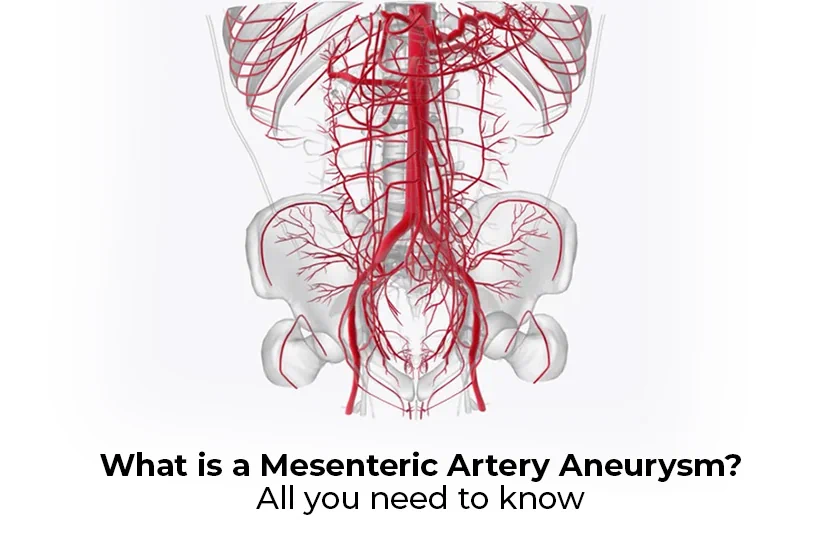
Unveiling the Mysteries of a Mesenteric Artery Aneurysm
As a vascular surgeon, each day brings new challenges and triumphs, but one patient remains etched in my memory.
A middle-aged gentleman walked into my clinic, complaining of vague abdominal pain and an unexplained sense of fullness. His symptoms were perplexing, and after a series of diagnostic tests, we uncovered the culprit: a mesenteric artery aneurysm.
This rare condition, often overshadowed by its more infamous counterparts, demanded immediate attention and expert care.
Through his journey, I learned the intricacies and potential dangers of mesenteric artery aneurysms, a condition I believe deserves more awareness and understanding.
What is a Mesenteric Artery Aneurysm?
A mesenteric artery aneurysm is a bulge or ballooning in the wall of one of the arteries that supply blood to the intestines. The mesenteric arteries, including the superior mesenteric artery (SMA) and the inferior mesenteric artery (IMA), are critical for providing oxygen-rich blood to the abdominal organs.
When the wall of these arteries weakens, it can lead to an aneurysm. Although mesenteric artery aneurysms are rare, they can be life-threatening if they rupture, leading to internal bleeding and potentially fatal consequences.
Types of Mesenteric Artery Aneurysms
Superior Mesenteric Artery Aneurysm (SMAA): This type involves the superior mesenteric artery, which supplies blood to most of the small intestine and part of the large intestine. SMA aneurysms are the most common type of mesenteric artery aneurysms.
Inferior Mesenteric Artery Aneurysm (IMAA): This type affects the inferior mesenteric artery, which supplies blood to the lower part of the large intestine. These aneurysms are less common but still pose significant risks.
Causes of Mesenteric Artery Aneurysm
Understanding the causes of mesenteric artery aneurysms is crucial for prevention and early detection. Several factors can contribute to the development of these aneurysms:
- Atherosclerosis: This condition, characterized by the buildup of plaque in the arteries, is a leading cause of mesenteric artery aneurysms. Plaque can weaken the arterial walls, making them more prone to ballooning.
- Infections: Certain bacterial infections can lead to the formation of aneurysms. These infections can weaken the arterial walls, increasing the risk of an aneurysm.
- Trauma: Injuries to the abdomen, such as those sustained in accidents, can damage the mesenteric arteries and lead to aneurysm formation. Even surgery on adjacent organs can lead to unnoticed injuries which present later as aneurysms or pseudoaneurysms.
- Genetic Factors: Some individuals may have a genetic predisposition to aneurysms. Conditions like Marfan syndrome and Ehlers-Danlos syndrome, which affect connective tissues, can increase the risk.
- Inflammatory Diseases: Conditions like vasculitis, which cause inflammation of the blood vessels, can weaken the arterial walls and lead to aneurysms.
Symptoms of Mesenteric Artery Aneurysm
Mesenteric artery aneurysms often present with non-specific symptoms, making them challenging to diagnose. However, recognizing the signs early can be lifesaving. Common symptoms include:
- Abdominal Pain: Persistent or recurring abdominal pain is a common symptom. The pain may be localized or diffuse and can vary in intensity.
- Nausea and Vomiting: These symptoms can occur due to reduced blood flow to the intestines or pressure exerted by the aneurysm on surrounding structures.
- Abdominal Mass: In some cases, a pulsating abdominal mass may be palpable.
- Gastrointestinal Bleeding: If the aneurysm ruptures, it can cause internal bleeding, leading to symptoms like blood in the stool, severe abdominal pain, and shock.
- Weight Loss: Unintentional weight loss may occur due to reduced appetite and gastrointestinal symptoms.
What are the Stages of a Mesenteric Artery Aneurysm?
Mesenteric artery aneurysms can progress through several stages, each with increasing severity and risk:
- Initial Formation: In the early stages, the aneurysm begins to form due to the weakening of the arterial wall. This stage is often asymptomatic and may go unnoticed.
- Expansion: As the aneurysm grows, it can cause symptoms like abdominal pain and discomfort. The risk of rupture increases as the aneurysm expands.
- Rupture: The most critical stage is when the aneurysm ruptures, leading to internal bleeding. This stage is a medical emergency and requires immediate intervention.
- Complications: If left untreated, a ruptured aneurysm can lead to severe complications, including shock, organ failure, and death.
What Treatments Are Available for a Mesenteric Artery Aneurysm?
Treatment options for mesenteric artery aneurysms depend on the size, location, and severity of the aneurysm, as well as the patient’s overall health. Common treatments include:
Observation: Small, asymptomatic aneurysms may be monitored with regular imaging studies to track their growth. Lifestyle changes and medications to manage underlying conditions like atherosclerosis may also be recommended.
Medications: Medications to control blood pressure, cholesterol levels, and other risk factors can help slow the progression of the aneurysm.
Surgery: Surgical intervention is often required for larger or symptomatic aneurysms. Options include:
Open Surgery: The aneurysm is surgically removed and the artery is repaired with a graft. This traditional approach is highly effective but involves a longer recovery time.
Endovascular Repair: A less invasive procedure where a stent graft is inserted through a catheter to reinforce the weakened artery. This has the advantage of preserving blood flow through the mesenteric artery, while sealing blood flow in to the aneurysm. This approach has a shorter recovery time but may not be suitable for all patients. In case the aneurysm is large and covered stent is not possible, then angioembolisation with coils can be done to seal the aneurysm.
Emergency Surgery: In the case of a ruptured aneurysm, emergency surgery is necessary to stop the bleeding and repair the artery. The prognosis depends on how quickly treatment is initiated.
What are the Risks of Aneurysm Repair?
While aneurysm repair can be lifesaving, it carries certain risks, especially in emergency situations. Potential risks include:
- Infection: Surgical procedures carry a risk of infection, which can complicate recovery.
- Bleeding: There is a risk of bleeding during and after surgery, which may require transfusions or additional interventions.
- Organ Damage: The proximity of the mesenteric arteries to vital organs means that there is a risk of damaging these organs during surgery.
- Clot Formation: Blood clots can form in the repaired artery or the graft, leading to complications like stroke or organ damage.
- Recurrence: There is a possibility that a new aneurysm could form in the same or a different location.
Conclusion
Mesenteric artery aneurysms, though rare, pose significant health risks and require prompt diagnosis and treatment. Awareness of the causes, symptoms, and treatment options is crucial for early intervention and successful outcomes. In India, where healthcare access and awareness are continually improving, it is vital to stay informed about such conditions.
In Vadodara, Dr. Sumit Kapadia is a leading vascular surgeon with extensive experience in diagnosing and treating mesenteric artery aneurysms. His expertise and dedication to patient care make him a trusted name in the field of vascular surgery. If you or a loved one experiences symptoms suggestive of a mesenteric artery aneurysm, seeking prompt medical attention from a specialist like Dr. Kapadia can make all the difference.
FAQs
A mesenteric artery aneurysm occurs in the arteries that supply blood to the intestines, while an aortic aneurysm occurs in the aorta, the main artery that carries blood from the heart to the rest of the body. Both conditions involve a bulge in the arterial wall but affect different parts of the circulatory system.
Yes, lifestyle changes such as maintaining a healthy diet, exercising regularly, quitting smoking, and managing conditions like hypertension and high cholesterol can help reduce the risk of developing aneurysms.
Mesenteric artery aneurysms are typically diagnosed through imaging studies such as ultrasound, CT scans, or MRI. These tests can help visualize the aneurysm and assess its size and location.
If you experience symptoms such as severe abdominal pain, nausea, vomiting, or signs of gastrointestinal bleeding, seek medical attention immediately. Early diagnosis and treatment are critical for preventing complications.
Not always. Small, asymptomatic aneurysms may be monitored with regular imaging, while larger or symptomatic aneurysms typically require surgical intervention. The treatment approach depends on the size, location, and severity of the aneurysm.

MBBS, MS, MRCS, DNB-Fellow
Dr. Sumit Kapadia
Dr. Sumit Kapadia / MR KAPADIA SUMIT a gold-medalist from Baroda Medical College, obtained his general surgical training and senior residency from SSG Hospital, Vadodara.

MBBS, MS, MRCS, DNB-Fellow
Dr. Sumit Kapadia
Dr. Sumit Kapadia / MR KAPADIA SUMIT a gold-medalist from Baroda Medical College, obtained his general surgical training and senior residency from SSG Hospital, Vadodara.




